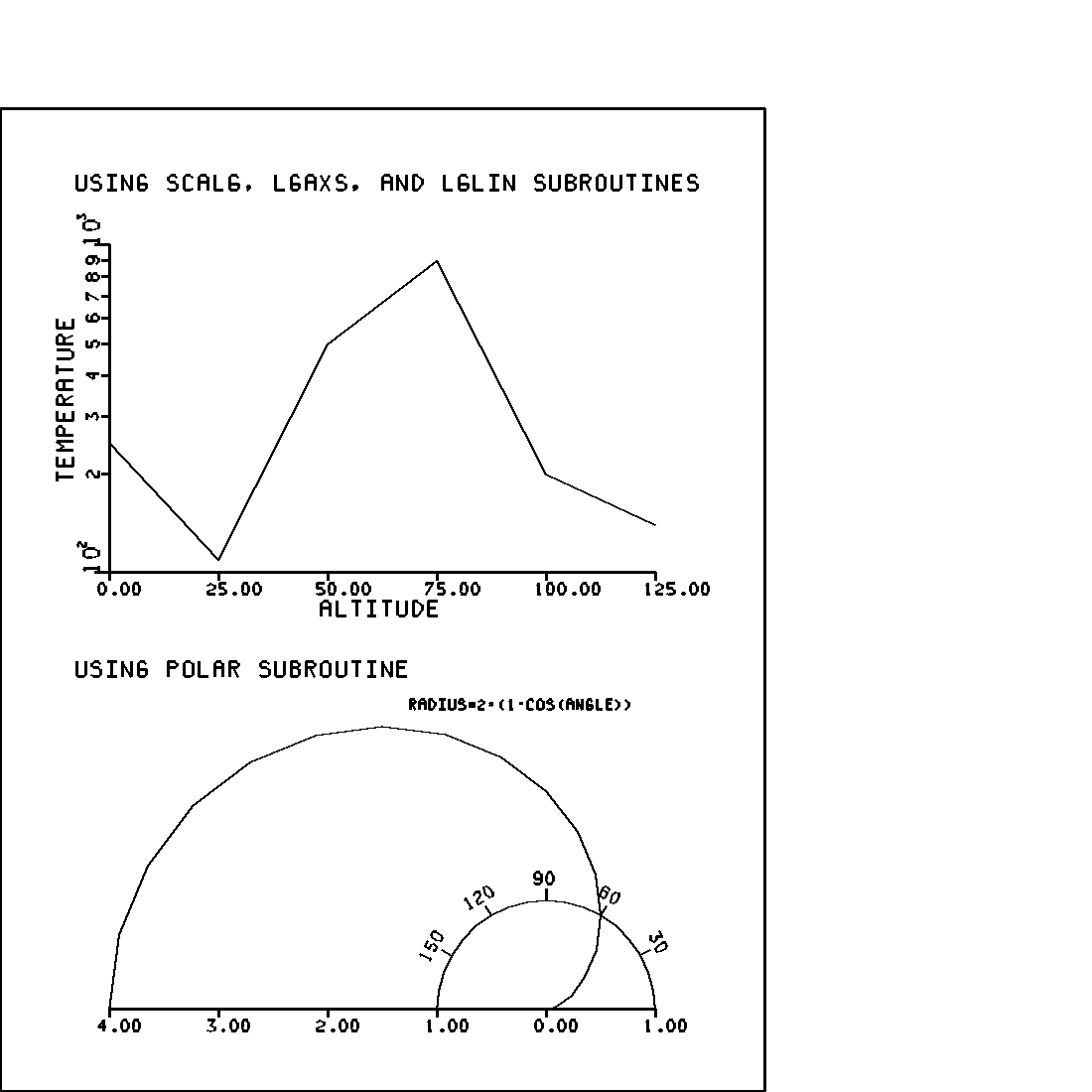Manual Reference Pages - scalg (3)
NAME
scalg(3f) - [M_calcomp:scientific] determine scale factors for a logarithmic scale (LICENSE:PD)
CONTENTS
Synopsis
Description
Options
Examples
Example
License
SYNOPSIS
subroutine scalg(array,axlen,npts,inc)
DESCRIPTION
SCALG is a FORTRAN subroutine used to determine scale factors of a data array to be plotted on a logarithmic scale. The scale factors are those used by subroutines LGLIN and LGAXS. SCALG is similar in operation to SCALE.
OPTIONS
ARRAY is the array containing the data to be scaled. The FORTRAN DIMENSION statement must specify at least two elements more than the number of values being scaled, to allow room for SCALG to store the computed starting value and scaling factor at the end of the array. AXLEN is the maximum length, in inches, over which the data is to be plotted. NPTS is the number of values in ARRAY to be scaled. INC is the increment between elements of the array to be plotted. INC is greater than 1 if the values to be plotted are in a mixed or multi-dimensioned array. (Normally INC = 1).
COMMENTS
The array must be dimensioned with at least NPTS + 2 elements. The adjusted minimum value (FIRSTV) and the delta value (DELTAV) are stored by SCALG in the data array.
The adjusted minimum is stored in ARRAY (NPTS*INC + 1), and the adjusted delta (log cycles per inch) is in ARRAY (NPTS*INC + INC + 1) . Therefore, ARRAY must be dimensioned to be at least NPTS*INC+INC+1 .
Every INCth element of the array ARRAY, beginning with the first, is scanned to find the minimum and maximum values of the array. Next, the greatest value of 10**n (integer n) less than or equal to the minimum value is found and then stored in ARRAY (NPTS*INC + 1). Finally, the smallest value of 10**m (integer m) greater than or equal to the maximum value is established.
The delta value is the difference between the minimum and maximum powers of ten, divided by AXLEN, yielding log cycles per inch. The delta value is stored in ARRAY (NPTS*INC + INC + 1).
EXAMPLES
Various examples:
A. For the following array of valuesARRAY(1) = 1500.0 ARRAY(2) = 3000.0 ARRAY(3) = 2500.0 ARRAY(4) = 300.0
and the following argument values
AXLEN = 1.0 NPTS = 4 INC = 1
the adjusted minimum (FIRSTV) and delta value (DELTAV) stored by SCALG are:
FIRSTV: ARRAY(5) = 100.0 DELTAV: ARRAY(6) = 2.0
B. If the value of AXLEN in Example A were changed to 4.0, the resultant values stored would be:
FIRSTV: ARRAY(5) = 100.0 DELTAV: ARRAY(6) = 0.5 C. For the following array of values ARRAY(1) = 1.2* ARRAY(2) = 100.0 ARRAY(3) = 2.3* ARRAY(4) = 88.0 ARRAY(5) = 1.8* ARRAY(6) = 0.0 ARRAY(7) = 0.8* ARRAY(8) = 10.0 ARRAY(9) = 0.7* ARRAY(10) = 10.0and the following argument values:
AXLEN = 10.0 NPTS = 5 INC = 2
the adjusted minimum (FIRSTV) and delta value (DELTAV) are determined from the value of the asterisked items (1, 3, 5, 7, and 9) in the above array. The computed values are also stored two subscript elements apart.
FIRSTV: ARRAY(11) = 0.1 DELTAV: ARRAY(13) = 0.2
EXAMPLE
Sample program:
program demo_scalg use M_calcomp implicit none ! based on concepts of CALIFORNIA COMPUTER PRODUCTS, 1968 character(len=50) :: ibcd integer :: i, k integer :: inteq real :: a real :: angl real :: angle(19) real :: bang real :: beta real :: r(19) real :: theta real :: x real :: xx real :: xa,ya, xb,yb, xc,yc, xd,yd real :: xar(8)= [ 1.00, 2.00, 3.00, 4.00, 5.00, 6.00 , 0.0, 0.0 ] real :: yar(8)= [ 250.0, 110.0, 500.0, 900.0, 200.0, 140.0 , 0.0, 1.0 ] call plots(0.0,10.0,0.0,10.0) ! DRAW FRAME call plot(7.0,0.0,2) call plot(7.0,9.0,2) call plot(0.0,9.0,2) call plot(0.0,0.0,2) ! DRAW COMMENTS ibcd=’USING SCALG, LGAXS, AND LGLIN SUBROUTINES’ call symbol(0.7,8.25,0.14,ibcd,inteq,0.0,42) ibcd=’USING POLAR SUBROUTINE’ call symbol(0.7,3.80,0.14,ibcd,inteq,0.0,22) ! AXIS IS DRAWN ibcd=’ALTITUDE’ call axis(1.0,4.75,ibcd,-8,5.0,0.0,0.0,25.0) call scalg(yar,3.0,6,1) ibcd=’TEMPERATURE’ call lgaxs(1.0,4.75,ibcd,11,3.0,90.0,yar(7),yar(8)) call scale(xar,5.0,6,1) call plot(1.0,4.75,-3) call lglin(xar,yar,6,1,0,1,1) call plot(-1.0,-4.75,-3) ! POLAR SUBROUTINE IS USED x=0.0 do k=1,19 theta=x*0.0174533 r(k)=2.0*(1.0-cos(theta)) angle(k)=theta x=x+10.0 enddo call plot(5.0,0.75,-3) call polar(r,angle,19,1,0,1,0.0,1.0) angl =30.0 a=1.0 do i=1,5 theta=angl *0.0174533 xa=cos(theta) ya=sin(theta) call plot(xa,ya,3) xb=1.1*xa yb=1.1*ya call plot(xb,yb,2) xc=xb+0.05*xa yc=yb+0.05*ya if((i-3).gt.0)then a=1.5 endif beta=1.570797-theta xd=xc-0.105*a*cos(beta) yd=yc+0.105*a*sin(beta) bang=270.0+angl call number(xd,yd,0.105,angl, bang,-1) angl =angl +30.0 enddo xx=0.0 do i=1,19 angle(i) = xx*0.0174533 r(i) = 1.0 xx=xx+10.0 enddo call polar(r,angle,19,1,0,1,0.0,1.0) call plot(-5.0,-0.75,-3) ! AXIS IS DRAWN ibcd=’’ call axis(1.0,0.75,ibcd,-1,4.0,0.0,4.0,-1.0) call axis(5.0,0.75,ibcd,-1,1.0,0.0,0.0,1.0) ibcd=’RADIUS=2*(1-COS(ANGLE))’ call symbol(3.75,3.5,0.09,ibcd,inteq,0.0,23) call plot(11.0,0.0,999) end program demo_scalg
LICENSE
Public Domain
| scalg (3) | March 11, 2021 |
